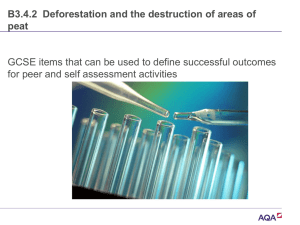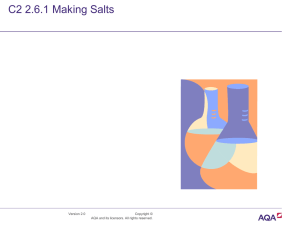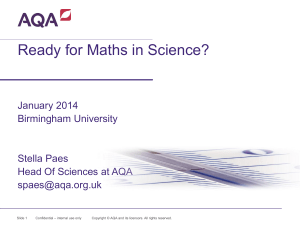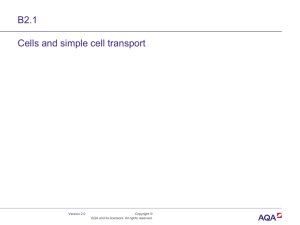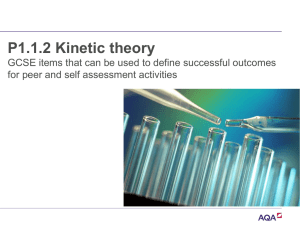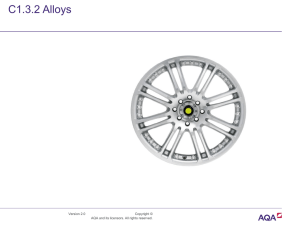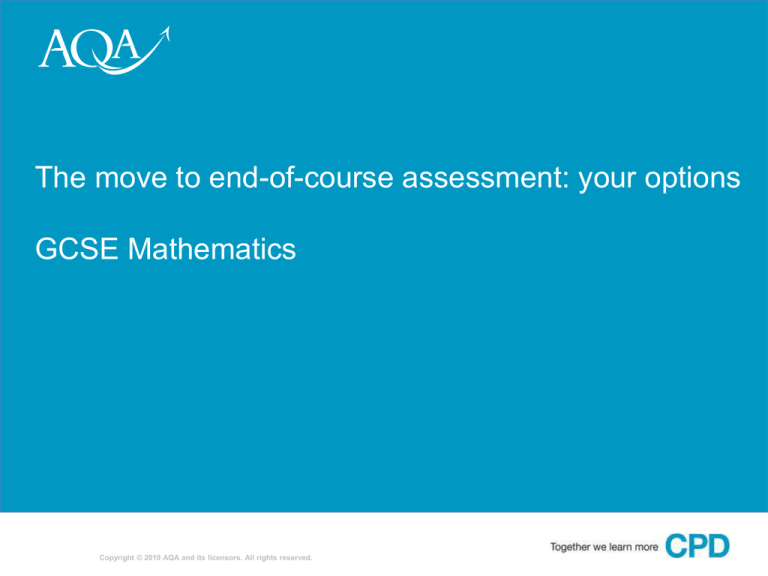
The move to end-of-course assessment: your options
GCSE Mathematics
1
Copyright © 2010 AQA and its licensors. All rights reserved.
Structure of the session
2
•
Assessment changes
•
Pathways through mathematics
•
Implications for departments
•
Teaching tips and revision
•
Resources
Copyright © 2010 AQA and its licensors. All rights reserved.
“Modular to linear” – what does it mean?
•
From June 2014, all assessment will have to be taken in a single
series
•
Students should usually take this assessment at the end of the
course
•
Taking all the exams at the end of the course does not necessarily
mean using the linear specification
•
The end of the course might not be at the end of KS4
3
Copyright © 2010 AQA and its licensors. All rights reserved.
Changes to the specification
•
Until the outcome of the National Curriculum review, all changes
relate to assessment regulations – the mathematical content doesn’t
change
•
The definition of “end of course” still needs to be clarified. DfE aims
are to reduce needless early entry, which AQA supports. However,
some students are able to complete GCSEs early and move on to
further study
4
Copyright © 2010 AQA and its licensors. All rights reserved.
Changes to AQA’s papers
•
No change in content or rigour
•
Change in numbering
1 (a) (i) and 1 (a) (ii) become 1 (a) and 1 (b)
•
Change in spacing
more space between questions, within explanatory text and
between working lines and answer line
•
Removal of unnecessary wording
•
Bordering of tables lightened to become less obtrusive
•
Constant focus on minimising number and difficulty of words
5
Copyright © 2010 AQA and its licensors. All rights reserved.
Examples
Here is a triangle.
30°
x°
75°
Work out the value of x.
………………………………………………………….........
…....................................................................................
Answer …………………………………
6
Copyright © 2010 AQA and its licensors. All rights reserved.
Not everything can be omitted…
B
115°
x°
25°
This information is vital.
Technically, without it the question
cannot be answered.
A
AB is a straight line.
Work out the value of x.
7
Copyright © 2010 AQA and its licensors. All rights reserved.
Ofqual announcement – 24 February 2012
We today announced moves to strengthen GCSEs in English literature,
mathematics, history, and geography.
Chief Executive Glenys Stacey said: "We are tightening GCSEs in
these key subjects to make sure students cover the whole curriculum."
"We want our young people to have the best possible educational
experience, with qualifications that prepare them for the future."
"The exam boards have welcomed this steer from the regulator and are
to look again at these qualifications and how the rules are interpreted to
make sure that young people taking them have to study an appropriate
range and depth of the subject.”
8
Copyright © 2010 AQA and its licensors. All rights reserved.
Ofqual announcement – 24 February 2012
The planned timetable for the changes to GCSEs is as follows:
•
Geography to be tightened for first teaching in September 2012
•
History and English literature to be tightened up for first teaching in
September 2013
•
9
Mathematics papers improved from November 2012
Copyright © 2010 AQA and its licensors. All rights reserved.
4360 – AQA’s Unitised Specification
•
3 distinct units
• Unit 1: Statistics & Number
(26.7%) – calculator allowed
• Unit 2: Number & Algebra
(33.3%) – non-calculator
• Unit 3: Algebra & Geometry
(40%) – calculator allowed
10
Copyright © 2010 AQA and its licensors. All rights reserved.
Advantages of the Unitised Specification
•
The content of each unit is defined
•
Revision can be focused on specific topics in the short term
•
Two thirds of the examination can be done with a calculator
•
Exams are relatively short (1 hr, 1 hr 15 mins, 1 hr 30 mins)
•
Students can take different units at different tiers
11
Copyright © 2010 AQA and its licensors. All rights reserved.
Mixing between tiers in the unitised specification
Higher
Foundation
Foundation
Grade
Unit 1
maximum UMS
=80
Unit 2
maximum UMS
=100
Unit 3
maximum UMS
=120
Overall
Maximum
UMS=300
A*
72 – 80
90 – 100
108 – 120
270 – 300
A
64 – 71
80 – 89
96 – 107
240 – 269
56 – 63
70 – 79
84 – 95
210 – 239
C
48 – 55
67 60 – 69
72 – 83
180 – 209
D
40 – 47
50 – 59
60 – 71
150 – 179
E
32 – 39
40 – 49
48 – 59
120 – 149
F
24 – 31
30 – 39
36 – 47
90 – 119
G
16 – 23
20 – 29
24 – 35
60 – 89
U
0 – 15
0 – 19
0 – 23
0 – 59
B
12
60
Copyright © 2010 AQA and its licensors. All rights reserved.
4365 – AQA’s Linear Specification
•
Currently has a January entry which will not be allowed beyond
January 2013. This will become a November entry.
•
Distinct from other linear qualifications because 60% is calculator
assessment
13
Copyright © 2010 AQA and its licensors. All rights reserved.
Advantages of the Linear Specification
•
Two examination papers instead of three
•
Schemes of work are more flexible
•
Classwork and homework is more varied
•
General revision
•
Better preparation for A-Level, with apparently unrelated skills
required to answer some questions
14
Copyright © 2010 AQA and its licensors. All rights reserved.
Topics linked in the Linear Specification
•
Pattern in a sequence using shapes
•
Frequency table with unknown value represented as x
•
Surd simplification in a Pythagoras question
•
Reverse percentages in a geometry setting (area, volume)
•
Probability question requiring an algebraic solution
•
Discrete frequency distribution mean where both statistical methods
and arithmetic are being tested
15
Copyright © 2010 AQA and its licensors. All rights reserved.
Topics linked in the Linear Specification (continued)
•
Averages and range with algebraic expressions, surds, numbers in
standard form
•
Bounds involving geometry, compound measures, scales and units
•
Data handling questions involving properties of shapes or numbers
•
Standard form with compound measures, scale, trigonometry
•
Probability using shapes
Also
• Number questions only on Unit 2 which require the use of a
calculator
16
Copyright © 2010 AQA and its licensors. All rights reserved.
Timeline 1
Units 1, 2 & 3
available and
marks from
previous
examination
series can be
used towards
certification
Units 1, 2 & 3
available and
marks from
previous
examination
series can be
used towards
certification
Units 1, 2 & 3
available and
marks from
previous
examination
series can be
used towards
certification
Units 1, 2 & 3
available and
marks from
previous
examination
series can be
used towards
certification
4360 : Unitised specification
June 2012
November 2012
January 2013
Linear
examinations &
certification
available
AQA hope to
offer linear
examinations,
pending
confirmation
from Ofqual
Linear
examinations &
certification
available
March 2013
4365 : Linear specification
17
Copyright © 2010 AQA and its licensors. All rights reserved.
June 2013
Linear
examinations &
certification
available
Timeline 2
Units 1, 2 & 3
available and
marks from
previous
examination
series can be
used towards
certification
No
examinations
available
No
examinations
available
Units 1, 2 & 3
available but all
must be taken
in this
examination
series to ensure
certification
Units 1, 2 & 3
available but all
must be taken
in this
examination
series to ensure
certification
4360 : Unitised specification
November 2013
AQA hope to
offer linear
examinations,
pending
confirmation
from Ofqual
January 2014
No
examinations
available
March 2014
No
examinations
available
June 2014
November 2014
Linear
examinations &
certification
available
Linear
examinations &
certification
available
4365 : Linear specification
18
Copyright © 2010 AQA and its licensors. All rights reserved.
Changes to performance tables
Following the Wolf report, the Government is reforming performance
tables from summer 2014:
•
all qualifications will count as one in Key Stage 4 performance
indicators (irrespective of size/number of guided learning hours)
•
dual award GCSEs will still count as two separate qualifications
•
existing full course GCSEs, established iGCSEs and AS-levels will
count towards all existing measures in Key Stage 4 performance
tables
19
Copyright © 2010 AQA and its licensors. All rights reserved.
What the changes mean for you
Qualification
Included in
performance tables
from 2014?
Counted as maths
qualification headline
performance
measures?
GCSE Maths 4360
GCSE Maths 4365
Yes
Yes
Linked pair pilot
comprising:
Yes
Yes
(either qualification
counts but both must be
taken)
GCSE Methods in Maths
&
GCSE Applications of
Maths
20
Copyright © 2010 AQA and its licensors. All rights reserved.
What the changes mean for you
Qualification
Included in
performance tables
from 2014?
Counted as maths
qualification headline
performance
measures?
Yes
No
No
No
Level 1/2 Certificate in Use
of Maths
Level 2 Certificate in
Further Maths
Functional skills at all levels
Entry Level Certificate
Level 1 and Level 2 FSMQ
21
Copyright © 2010 AQA and its licensors. All rights reserved.
Implications for Maths departments
22
Copyright © 2010 AQA and its licensors. All rights reserved.
Schemes of work
Staying with Unitised
•
Maintain discrete schemes of work for each unit
•
Mix up the units and delineate in revision and practice
Changing from Unitised to Linear
•
Keep the same scheme of work, but link in related topics
•
Keep the same basic scheme, but change the order
•
Devise a new scheme
Whatever you decide, the customisable All About Maths route map will
help
23
Copyright © 2010 AQA and its licensors. All rights reserved.
Lesson plans
Staying with Unitised
•
Lesson plans shouldn’t need changing
Changing to Linear
•
Review plans to include related topics
•
Ensure that Unit 2 plans now include numbers requiring a calculator
24
Copyright © 2010 AQA and its licensors. All rights reserved.
Homework
Staying with Unitised
•
How is homework structured to foster retention of knowledge?
•
How does homework change prior to exams?
Changing to Linear
•
Two types of homework – discrete and continuous
•
Topic-based homework from sheets or online
•
General homework built up according to scheme of work
25
Copyright © 2010 AQA and its licensors. All rights reserved.
Revision: 10 starter questions (Unit 2 Foundation Tier)
1. Use the digits 3, 4, 6 and 9 once each to make the largest possible even number.
2. Jack has four coins. Three of them are the same. He has 17p. What are his four coins?
3. Write down the value of 7²
4. Work out 9 + 4 × 3
5. Solve
𝑥
4
= – 10
6. Factorise 6x – 30
7. What is the cube root of 1000?
8. Expand and simplify 4(2x – 1) + 5(3x + 2)
9. Half of a number is 15. What is three times the number?
1
3
10. Write down a fraction between 5 and 8
26
Copyright © 2010 AQA and its licensors. All rights reserved.
Revision: 10 starter questions (Unit 2 Higher Tier)
1. Simplify 5x – 4y + 8x – 2y
2. Simplify 𝑥 6 × 𝑥 3
3. After a reduction of 20% a book cost £12. What was its original price?
4. Factorise 𝑥 2 + 3x - 10
5. Solve
𝑥
4
= – 10
6. Rearrange the formula F =
3𝑎−𝑏
7
to make a the subject
7. Work out the equation of the line, parallel to the line y = 2x – 8, which goes through the point (3, 10)
8. Express 63 in the form a 𝑏, where a and b are prime numbers
9. Rationalise the denominator of
12
3
10. Prove that the sum of the squares of consecutive integers is always odd
27
Copyright © 2010 AQA and its licensors. All rights reserved.
Revision: 10 starter questions (Linear P1 Foundation Tier)
1. Use the digits 3, 4, 6 and 9 once each to make the largest possible even number.
2. Jack has four coins. Three of them are the same. He has 17p. What are his four coins?
3. Work out the mean of 3, 5, 6, 8, and 13
4. Work out 9 + 4 × 3
5. Solve
𝑥
4
= – 10
6. Factorise 6x – 30
7. What is the probability of a fair dice landing on a prime number?
8. Expand and simplify 4(2x – 1) + 5(3x + 2)
9. Half of a number is 15. What is three times the number?
10. Which quadrilateral has only one pair of parallel sides?
28
Copyright © 2010 AQA and its licensors. All rights reserved.
Revision: 10 starter questions (Linear P1 Higher Tier)
1. Simplify 5x – 4y + 8x – 2y
2. Work out the volume of a triangular prism with base 6cm, perpendicular height 10cm and length 15cm
3. After a reduction of 20% a book cost £12. What was its original price?
4. If the sin of an angle is 0.6 what is the tan of the angle?
5. Solve
𝑥
4
= – 10
6. Rearrange the formula F =
3𝑎−𝑏
7
to make a the subject
7. Work out the equation of the line, parallel to the line y = 2x – 8, which goes through the point (3, 10)
8. What is the frequency density of a class width of 5 with a frequency of 25?
9. Rationalise the denominator of
12
3
10. Prove that the sum of the squares of consecutive integers is always odd
29
Copyright © 2010 AQA and its licensors. All rights reserved.
Teaching tips and revision
30
Copyright © 2010 AQA and its licensors. All rights reserved.
Teaching tips 1
•
Get students to think by extending questions, for example
Bill buys eight bottles of cola for £4.00.
What is the cost of each bottle?
A routine question with little thinking required.
But what about ...
If you buy ten bottles you get a 5% discount.
Is buying six bottles a week a good idea?
31
Copyright © 2010 AQA and its licensors. All rights reserved.
Teaching tips 2
•
Which ‘item’ is the odd one out? For example:
Give a reason why each of these numbers is the odd one out.
19
28
33
65
72
19: only prime number
28: only triangular number
33: only multiple of 11
65: only one which can be expressed as the sum of two different squares
72: only one which is the number of degrees in the exterior angle of a
regular polygon
32
Copyright © 2010 AQA and its licensors. All rights reserved.
Teaching tips 3
•
Do you agree or disagree?
For example:
If you divide a number by ½ you get a smaller number.
Dividing a number by ½ is the same as multiplying it by 2.
Does this mean you always get a bigger number?
Not when the number is 0.
What about negative numbers; is -8 bigger than -4?
33
Copyright © 2010 AQA and its licensors. All rights reserved.
Teaching tips 4
•
What is the same? What is different?
Example:
Special offers on tins on beans.
Shop A
Buy 2 get 1 free
Shop B
⅓ off normal price
The offers are the same if you buy three tins.
The offers are the same if you buy 3n tins.
What if the price is not a multiple of 3?
34
Copyright © 2010 AQA and its licensors. All rights reserved.
Teaching tips 5
•
Look for the mathematics in a situation, for example:
In school our lives are ruled by the timetable.
How is it made up?
Could we make a better one?
Dividing time into lessons, breaks and lunch.
Number of teachers and number of classes.
Combinations and permutations.
35
Copyright © 2010 AQA and its licensors. All rights reserved.
Teaching tips 6
•
Make questions purposeful (real life, functional), for example:
Recipe for 12 flapjacks
75g of butter or margarine
60g of light brown sugar
1 tablespoon of golden syrup
175g of porridge oats
You want to make 30 flapjacks.
You have no ingredients at present.
Make a shopping list – what do you need and how much will it all cost
Ratio
Pack size
Cost per unit
36
Copyright © 2010 AQA and its licensors. All rights reserved.
Support and resources
37
Copyright © 2010 AQA and its licensors. All rights reserved.
AQA tools to help you
•
AQA website
•
e-AQA, including
- ERA (Enhanced Results Analysis)
- Secure Key Materials
•
AQA All About Maths
38
Copyright © 2010 AQA and its licensors. All rights reserved.
AQA All About Maths
An online resource which includes
• Detailed assessment guidance
• Practice papers
• Worksheets and homework sheets
• Lesson plans that can be adapted to suit
• Route maps
• Exampro
• Mock Exams Analyser
39
Copyright © 2010 AQA and its licensors. All rights reserved.
Problem solving resources
Free resources on AQA All About Maths
40
Copyright © 2010 AQA and its licensors. All rights reserved.
AQA – related resources
•
Exampro
•
Teach it
•
Nelson Thornes / Kerboodle
•
Online Progress Tests
41
Copyright © 2010 AQA and its licensors. All rights reserved.
Where to get help
•
Subject Manager
mathematics-gcse@aqa.org.uk
0161 957 3852
•
Teacher Support Manager
teachercpd@aqa.org.uk
0161 957 3646
42
Copyright © 2010 AQA and its licensors. All rights reserved.

